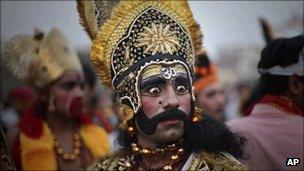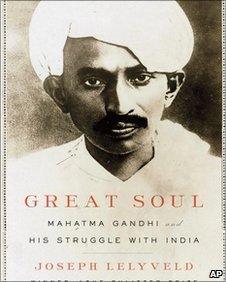Ramayana: An 'epic' controversy
- Published
- comments

Ramayana is India's most popular epic
"How many Ramayanas, external? Three hundred? Three thousand? At the end of some Ramayanas, a question is sometimes asked: How many Ramayanas have there been?" wondered the late poet and scholar AK Ramanujan , externalof the Indian epic in a compelling essay he wrote for a University of Pittsburgh conference in 1987.
Twenty four years later, the essay, Three Hundred Ramayanas:Five Examples and Three Thoughts on Translation, external, finds itself at the centre of a fresh controversy. It has been dropped from the history syllabus of Delhi University, external after protests from hardline Hindu groups and a number of teachers. They believe the many versions recounted in the essay offend Hindu beliefs.
As Dr Ramanujan tells the story, the number of versions of the epic which have existed in India and the rest of south-east Asia for the past 2,500 years or more is simply "astonishing". Though Valmiki's, external Sanskrit poem Ramayana is the most influential among Indians, Ram's story is available in at least 22 languages, including Chinese, Laotian, Thai and Tibetan. Many of these languages have more than one telling of the epic.
Popular epic
Twenty-five or more renditions of the epic in various genres - epics, poems, mythological stories - have been in Sanskrit , externalalone, wrote Dr Ramanujan. There are sculptures, mask plays, puppet plays and shadow plays around the epic. One researcher, Camille Bulcke, external, counted 300 tellings of the epic.
Millions of Indians have read and "watched" the epic in a popular comic book, external and a hit TV series, external. I remember the soap nearly shutting down India on Sunday mornings in the mid-1980s - streets would be deserted, shops would be closed and people would bathe and garland their TV sets before the serial began.
Hindu groups first protested , externalagainst the inclusion of Dr Ramanujan's essay in the syllabus in 2008. At that time, the head of Delhi University's history department was also assaulted by some hot heads. But the teachers had stuck to their guns and refused to drop the essay.

Many Indians have grown up on the epic's comic book version
Three years later, bowing to renewed pressure, the university's top academic body decided to take the essay out of the history syllabus, though, reportedly, a minority of teachers protested, external against the decision. One of them, Abha Dev Habib, described the decision as "very regressive and unfortunate".
So why have the right-wing groups railed against Dr Ramanujan's essay?
Journalist Sugata Srinivasaraju suggests that the groups love the "soap telling", external of the epic poem which iconises Ram and "want the narrative to retain the structure and simplicity of a bedtime story so that you fall asleep in consent and total belief as you listen to it". Literary critic Nilanjana S Ray writes in her blog, external that this may "have been part of the general climate of intolerance and the battle over who had the right to tell the country's history and its myths that was part of the Indian landscape between the 1980s and the 2000s". She talks about how self-appointed censors wilfully scan texts for "offensive" phrases.
Ms Ray is correct. Last year Mumbai University withdrew Rohinton Mistry's novel Such a Long Journey - shortlisted for the Booker Prize in 1991 - from its curriculum after the nationalist Shiv Sena, external staged protests against its "derogatory" references to party members. Mr Mistry said the move was "a sorry spectacle of book-burning".
Last year the state of Gujarat banned Pulitzer Prize-winning author Joseph Lelyveld's incisive Great Soul: Mahatma Gandhi and His Struggle With India, external long before it had been released in India. Gujarat's ruling Hindu nationalist politicians had been told that the book sensationalised Gandhi's friendship with a German man, who may have been homosexual. All this was far from true, but the ban stayed.
'Humiliated'
And everybody remembers how India swiftly banned Salman Rushdie's Satanic Verses, external in 1988 because some clerics said it had insulted Islam. The Indian-born Rushdie had said he was "hurt and humiliated" by the decision.

Gujarat banned a book on Gandhi in April
The attacks on freedom of expression by the right-wing fringe extend beyond India. This July, a screening of Sita Sings the Blues, an award-winning take on the epic by American animator Nina Paley, external, in New York was cancelled, external after a local Hindu group bombarded the organisers with hundreds of protest emails. A man attending a lecture by American Indologist Wendy Doniger, external in London in 2003 threw an egg at her. He was apparently incensed "by the sexual thrust of her paper on one of our most sacred epics".
Salil Tripathi, who has written a book on Hindu nationalist attacks on free expression, finds Hindu groups engaging in "competitive intolerance", external after realising that other faiths are able to "attract attention by challenging text, interpretations, films, books, music and imagery".
Many would agree with this. But the ease with which attacks on free expression can be mounted in a country which never tires of calling itself the world's largest democracy betrays a weak and inffectual state, which often fails to respect and protect dissenters. That, many believe, means mischievous, trouble-making minorities can easily subdue and attack dissent.